Beekeeping Tools
Grafting
|
|
|
|---|
|
Beekeeping Tools Grafting |
Grafting Tools
|
|---|
Tools for grafting honey bee larvae by transferring them from frames to artificial queen cell cups.
![]()
Swiss Type... This is an expensive precision instrument! It works alright, but it is not as easy to use as some of the others and represents poor value for money. In 2022, the price of these and slightly modified designs has come down considerably since Dave Cushman wrote this. R.P.

Magnified Swiss Type
A magnifying glass is fitted to the stem of this tool to enable those with less than perfect
eyesight to see more easily. I find this rather clumsy and unwieldy. (I use a binocular
attachment on my spectacles to provide magnification on those occasions that I need it.)
Magnified Czech Type
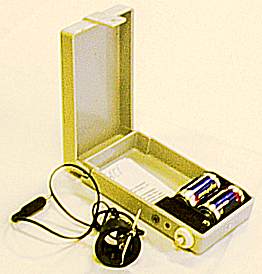
|
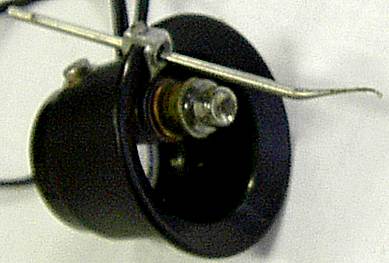
|
|---|
This inexpensive, magnified type has battery powered, focussed illumination with the tip of the grafting tool placed at the focus of the lens in the eyeglass. In use it is not placed to the eye, but is used at a comfortable viewing distance.
It comes in it's own carrying case that also houses the batteries and an on/off switch. The sample shown above was photographed at a BIIG meeting in 2003 and belongs to Ron Hoskins.
Chinese Type...
![]()
When I first tried these out I did not get on very well with them. I have returned to using them after a gap of about twelve years and I now find them ideal. They are inexpensive, but they are reliable. They are a little difficult to keep clean and I am suspicious that some of my failures may be due this fact. (The one above shows dirt between some of the handgrip wrappings.)
This one is shown about twice life size, it consists of a spring loaded bamboo plunger that slides along a thin tongue of flexible plastic. Modern versions of this tool have injection moulded plastic parts, which may help with cleanliness. To use, the flexible tongue slips easily under a larva and then a press on the plunger will deposit it, and any royal jelly that was picked up, in the cell to be grafted. In 2022, both bamboo and plastic are both available. I have used many of these, but I find them to be very variable in quality, depending on the manufacturer. They work best on older comb that has had several generations of brood, otherwise the "leaf" punches a slot in the base of the cell. Some are much easier to use than others, even when bought from the same supplier, so when you get a good one, look after it, though they don't last long before falling to bits. R.P.
![]()
Sable Hair Brush
The very small No 00 size artists brush is a nice tool to use for grafting, when moistened
the bristles stick together and can be easily slid under a larva. I find the next size up also works well. To get the larva off, I find you have to rotate the brush. R.P.
![]()
Homemade Types
These include wooden match sticks or toothpicks that have been softened by chewing and
fashioned with a penknife. I have used a strand from a barbed wire fence that I untwisted
and hammered into shape. This was my 'favourite' for many years until I lost it. The one
illustrated above was made just for the photograph.

|
A goose quill (as above) can be shaped with a sharp knife and the air resistance of the feather helps to steady shaky fingers. Quite frankly, I can't be bothered to fiddle around with paper clips, bent nails, etc. The right tools are inexpensive and work very well. R.P. One problem that I have personally is an inability to grip small or thin objects properly. I have overcome this by making a paddle shaped handle from 6 mm plywood and fixing a 100 mm length of stainless steel bicycle spoke with the end flattened and narrowed. The shaft is bent downwards at about 80° to keep the fingertips out of the way of vision. One feature of this paddle, that is difficult to indicate properly is that the surface is scalloped out on both sides to match the curvature of my fingertips as the yellow cross section illustrates. |
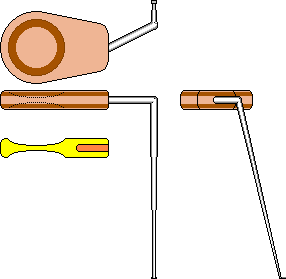
|
|---|
Illuminated grafting magnifier...
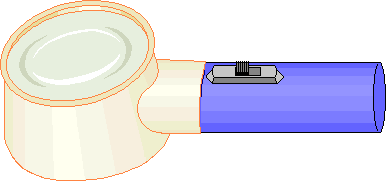
| These are sold for reading maps and have a couple of torch batteries in the handle. They focus on the surface that is in the exact plane of the rim, but by using comb that is shaved down heavily they may bring the larvae into focus. The grafting tool is introduced via a slot or hole in the side of the cone. If adequate focus is not obtained, the rim of the cone can be sawn off with a hacksaw to shorten the distance between the lens and the cell bottoms. |
|---|

The grafting tool shown above started life as a dental probe, but a little judicious grinding and re-polishing turns it into a good grafting tool, which, owing to the weight in the solid metal handle, has a very positive 'weighty' feel to it that aids slow and deliberate handling.
![]()
This green plastic tool is similar to the dental probe, it has been available in USA and Europe for some time, but as of August 2002, I have not seen them on sale in UK. In 2022, these with a blue aluminium handle have been available for several years. R.P.

|
This simple black plastic grafting tool seems rather crude at first sight and as it is sold it has a tip that is way too big for the purpose (see right). However it is made of a plastic that is soft enough to be trimmed with a craft knife or scalpel. The black colour contrasts with the white larva, which is useful as the larva should be no bigger than the egg that it came from. I recommend trimming the tip back to about 30% of it's length, reducing both the width and thickness by 50%. The scalpel should also be used to remove the mould flash line from the handle as this gives a disconcerting feel to sensitive fingers. |
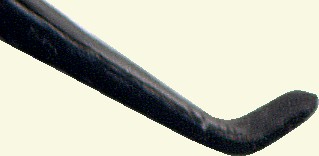
|
|---|
![]() This plastic grafting tool from JZ/BZ is similar in shape to the black plastic
one above, but has a tiny lip standing up from the tip.
This plastic grafting tool from JZ/BZ is similar in shape to the black plastic
one above, but has a tiny lip standing up from the tip.
Dave Cushman.
Page created Autumn 2000
Page updated 04/12/2022